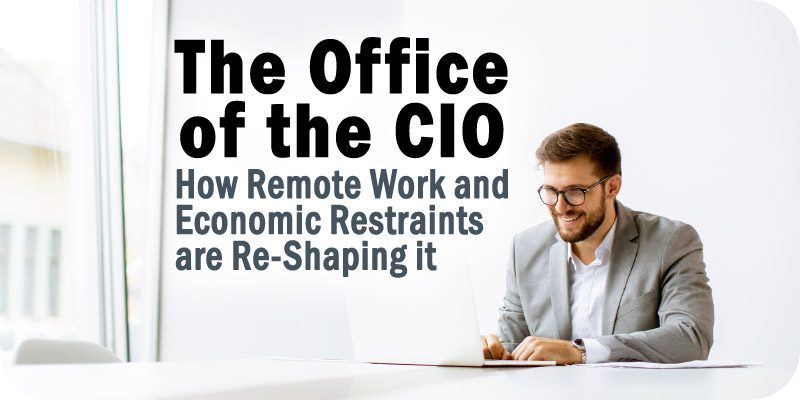How Remote Work and Economic Restraints are Shaping the Office of the CIO


As part of Solutions Review’s Expert Insights Series—a collection of contributed articles written by industry experts in enterprise software categories—Yassine Zaied, the Chief Strategy and Marketing Officer at Nexthink, explains how remote work and economic restraints can (and will) affect a Chief Information Officer (CIO).
 The past two years have changed how consumers shop, learn and connect. Almost every facet of our lives has been heavily influenced by remote working. As many countries are seeing economic downturns, the cultural shift will have its “rubber meets the road” moment. For Chief Information Officers (CIOs), this is showtime—their departments will be expected to automate more while minimizing any disturbances for employees and customers. So, what are the implications, considerations, and planning needed to succeed? And how can CIOs set their teams up for the future and ensure they can innovate for the next 5-10 years?
The past two years have changed how consumers shop, learn and connect. Almost every facet of our lives has been heavily influenced by remote working. As many countries are seeing economic downturns, the cultural shift will have its “rubber meets the road” moment. For Chief Information Officers (CIOs), this is showtime—their departments will be expected to automate more while minimizing any disturbances for employees and customers. So, what are the implications, considerations, and planning needed to succeed? And how can CIOs set their teams up for the future and ensure they can innovate for the next 5-10 years?
When Economic Pressure Looms, Look to Data from Your Digital Workplace Teams
Economic pressures are mounting, and a CIO will be on the line to feel the crunch. Over the next few months, teams will be pushed to reduce costs, payroll, and team size. Gartner’s latest findings show that despite economic concerns, IT spending will total $4.6 trillion in 2023, a 5.1 percent increase from 2022. While spending during an economic downturn can have significant competitive advantages, if spending isn’t put in the right place or money is left behind due to unnecessary overspending, companies will be worse off than before.
Digital workplace teams can showcase their strengths by helping leaders reduce operational costs—from delaying hardware refreshes to reducing costs spent on service desk providers paid by ticket. Regarding 2023 or even 2033 planning, the digital workplace team’s unique insights can also provide insight into headcount and hardware planning, SaaS application usage, and outsourcing service desk support contracts. Digital workplace teams are critical for insights and ongoing support. However, as strategic partners to the office of the CIO, ensuring their longevity and positioning that team as a future pool of candidates for the office of the CIO.
Innovation’s Disruptive Role
In economic disruption, we often take stock of what is becoming outdated and unused. In the rise of cloud computing, infrastructure teams quickly become irrelevant as backups and disaster recovery is outsourced through vendors. In a SaaS and cloud-first world, we don’t have any apps monitored by our teams. With web-hosted custom applications, while we can use APM technology to see the application code, it provides zero visibility into employees’ complete experience with these applications from their devices and browsers.
This creates considerable complexity, as IT is not fully seeing what’s happening. If you can’t see employees’ digital experiences, you’ll have a problem arise that you are blind to resolving. With remote work and a lack of a corporate network to fall back on, network teams (and network monitoring technology) are becoming irrelevant to the business as they lack visibility into the impacted environments—the individual employee devices.
This pattern of innovation creating positive disruption and monitoring consolidation has been seen in other industries. For example, I was speaking with a customer in Germany when we got on the topic of electric power distribution. For this region, the company selling the electricity didn’t control the power plant, and for any customer issues, they needed to rely on the power plant to identify any problems. However, this company was responsible for the customer relationship without any insight into where and when problems were occurring unless angry customers called in; it wasn’t until they placed monitoring in every house that they were able to ensure levels remained stable and powerful enough for customers and could even provide insight back into the power plant.
The Consolidation of Monitoring
Like the distribution of a power grid, the only way for digital workplace teams to have the visibility they need to ensure stable support will be by starting at the endpoints. In the future, only two primary monitoring technologies will be required by in-house IT and EUC teams: observability for development applications. This is monitoring the support for the applications being built for the business, ensuring they can understand the performance and customer needs. The second is watching employees’ experience with the apps they’re using. To do this effectively, you must look from the employee’s perspective.
In tough economic times, the role of the CIO and their departments will be tested. This is where disruptive innovation and digital workplace teams can shine. Companies that pull through the other side stronger than before will double down on innovation, prioritize employees, support customers, and look to creative ways to save money.



















